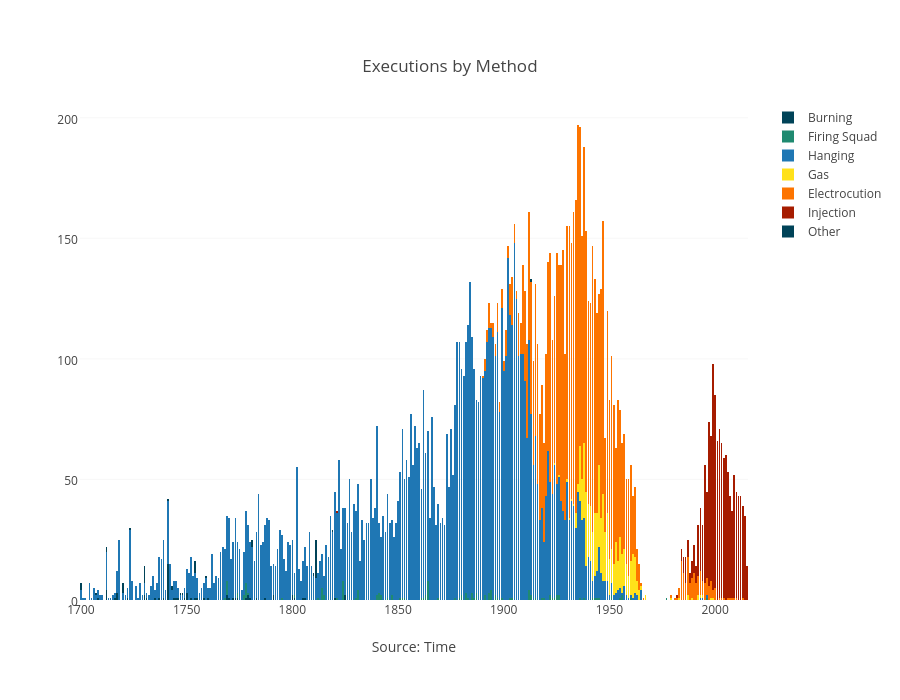Brief History of Capital Punishment in the United States
When European settlers came to North America, they brought Britain’s practice of the death
penalty with them. Capital punishment was a mainstay in the United States up until the early twentieth century,
when several states either outlawed or reduced capital punishment. Starting in the 1960s, there was a sharp decline in executions due to growing doubts about execution as a method of punishment. In 1967, an unofficial moratorium began on the death penalty. In 1972, the Furman v. Georgia case it was argued that capital cases were often
arbitrary and capricious. It was thus determined to be “cruel and unusual”, which led the
Supreme Court to invalidate the legality of capital punishment. Thus, there was a decade-long suspension
from 1967 until 1977.
The below graph, originally published by TIME, shows the trend of capital punishment over the past
few centuries.
The brief hiatus of the death penalty was brought to an end in the Gregg v. Georgia case in 1976, concluding that the death penalty was no longer in violation of the Eighth Amendment due to a new trial system.The subsequent execution of Gary Gilmore in Utah by firing squad in 1977 rang in a new era of executions.

Moratoriums, Formal Holds, and De Facto Moratoriums, oh my!
Determining when and where the death penalty is legal in the United States is complicated business.
While creating this interactive, we learned that the system does not simply rely on the binary of legal versus
illegal; rather, other statuses exist such as a Moratorium, a De Facto Moratorium, a Formal Hold, and a
De Facto Momento.
Particularly in the cases of De Facto Moratoriums and De Facto Momento, it is difficult to find reliable
information about the exact starting and ending dates for each of these phases (particularly since "de facto",
by definition, means "not by law").
For the sake of clarity, we chose to stick to the legal versus illegal binary in our map because that
is considered the "official status" for each state during the given year.
If you would like more detailed information about the status of a particular state, the Death Penalty Information Center's "Death Penalty in Flux" is a great resource.
Death of the Death Penalty?
David von Drehle, an author at TIME, staunchly believes that the death penalty is going to draw to a close
in the United States (though he does not specify when). However, as this interactive shows, there has been no dearth of executions since
the last time the death penalty nearly ended due to it being deemed "cruel and unusual". What are some reasons von Drehle
believes we will reach the end of the death sentence?
For one, he notes that the process is not particularly simple. Even with lethal injection, which is the most
"sanitized" method for execution that allows us to escape the gruesome nature of the practice, it does not
always work as expected.
Another reason von Drehle posits is that crime rates have fallen in the past decades (particularly in
comparison to 1990s rates), so public opinion is less in favor of the death penalty in general. It just
seems less necessary.
Another reason is simply that capital punishment comes with a hefty price tag. One may believe
it is less costly than a life sentence for a prisoner, but in actuality, the death penalty
can cost significantly more than life imprisonment due to additional costs of housing a
death row inmate, according to the Huffington Post.
Daniel Bier, writing for Newsweek, brings up an interesting point:
"Even if some people do deserve to die, should we invest the state with the awesome power to decide who lives and who dies? ... Currently, over 3,000 people are awaiting execution in the United States. Even if some or most of them deserve to die, is our faith in government so profound that we think that they are all guilty, that no mistakes have been made?"
Since the 1970s, a grand total of 1,407 people have been executed and 156 death row inmates have been exonerated.
None of this necessarily means that the death penalty will come to an end soon, but it is worth
considering whether the death penalty is worthwhile for the United States, given the cost, the risk of
executing innocent people, and the question of whether execution is the responsibility of the state at all.
About Us
Should the Death Penalty be Put to Death? is a collaboration between Natalee Desotell, Kai Brito, and Gaby Barrett. We created this interactive for Robert Roth and Robin Tolochko's Spring 2016 Interactive Cartography & Geovisualization course at the University of Wisconsin-Madison.
We created this project using the D3 library, jQuery, and Bootstrap.
A big thanks goes out to Professor Robert Rothand our teaching assistant Robin Tolochko for their help. The design of this project was inspired by Your Body, (Not) Your Choice, created by Robin Tolochko, Katie Kowalsky, and Dylan Moriarty.
Sources
Source code for "Your Body, Not Your Choice"
University of Michigan, Death Penalty Curriculum
Scientific American, How Many Prisoners on Death Row are Wrongfully Convicted?
Time, More Innocent People on Death Row than Estimated
Time: The Death of the Death Penalty
Huffington Post: Why Lethal Injection Drugs Don’t Always Work As Expected
Forbes: Considering The Death Penalty: Your Tax Dollars At Work
Death Penalty Information Center, Innocence List: Those Freed From Death Row